WHERE ARE THEY NOW?
PART ONE
Fifty years ago, BR remarkably allowed steam to run to Shildon under its own power for the big S&D 150 event. HOWARD JOHNSTON witnessed it all, and now tries to rediscover the key exhibits.

Strict health and safety rules were a lower priority in 1975 when BR allowed uncertified steam locos back onto its main lines to attend the ‘Rail 150’ Cavalcade and Exhibition at Shildon during the Bank Holiday week of August 24-31.
Those were the days when inspections were not so rigorous to secure ten-year certificates. Indeed, it has been speculated that a couple of the locomotives that notched up hundreds of miles to get to the show had not even had their boilers lifted after coming out of Barry scrapyard. Having devoted months of logistical planning to get the engines and vintage rolling stock from across the country, including Scotland, BR had such confidence in the owners that it didn’t give much thought to diesel haulage. As with the Rainhill exhibition five years later, it was a treat for linesiders that can never be repeated.
Crowd management was also in its infancy half a century ago, and the organisers must be congratulated because there were no mishaps of any consequence, even though an estimated 250,000 travelled to the North East for the spectacle. Steam had only ended on BR steam seven years previously in August 1968, and few were prepared for the sight of more than 30 polished engines running past them in a two-hour long show. However, whose bright idea was it to set out the tiered seating facing directly into the searing sun, which made photography near-impossible? People on the other side of the track who had not paid admission got the best views.
Eric Treacy, Bishop of Wakefield and one of our most revered steam photographers, was among those overwhelmed by having such close contact with engines he recalled from the 1940s and 1950s. He also admitted his disappointment at a few notable absentees. He mourned the lack of an LMS ‘Duchess/Coronation’ 462, but there were none available (No. 6229 Duchess of Hamilton was fresh out of Butlin’s holiday camp at Minehead and in a shabby state, and No. 6233 Duchess of Sutherland was still at Bressingham). Also missing, he said, were a GWR ‘Castle ‘or ‘King’, because of weight and gauge clearance issues perhaps?

Those with a keen eye for celebrities at the private/press launch would have noticed British film actor Kenneth More, artist and engine owner David Shepherd, Bishop Treacy, ‘Thomas the Tank Engine’ creator and author the Rev Wilbert Awdry, and photographer Derek Cross. Flying Scotsman owner Alan Pegler was also there, and part of the Cavalcade commentary team.
There was a universal dislike of BR’s prototype Class 252 High Speed Train, which arrived filthy and was too long to go through local carriage washers. Attempts to clean it by hand made matters worse because the handful of quickly allotted staff could only reach window height. Its appearance as the climax of the three-mile Cavalcade from Shildon to Heighington was met with loud ‘boos’.
At the end as well as the start, there were no crowd dispersal issues as people were routinely shuttled back to Darlington in sixteen 12-car DMUs.
Fifty years on, it is significant that one of the highly burnished Cavalcade engines – SR ‘S15’ No. 841 ‘Greene King’ – no longer exists, having been condemned with twisted frames, and surrendering its boiler to a classmate. The prototype High Speed Train has been also been disbanded, and one of its power cars was broken up in 1990. All the main line diesels that hauled the excursion trains have been scrapped (with two exceptions – Class 47s Nos. 47596 and 47727), and most of the shuttle DMUs likewise. Very few of the BR Mk 1 support coaches that arrived with steam are also still with us.
And 2025? Anyone considering assembling a similar locomotive line-up today would experience great difficulty. Many of the 1975 engines are unfit to run, have changed hands once or several times, and are at new locations. A handful have current main line certificates, but the rest are on static display in museums.
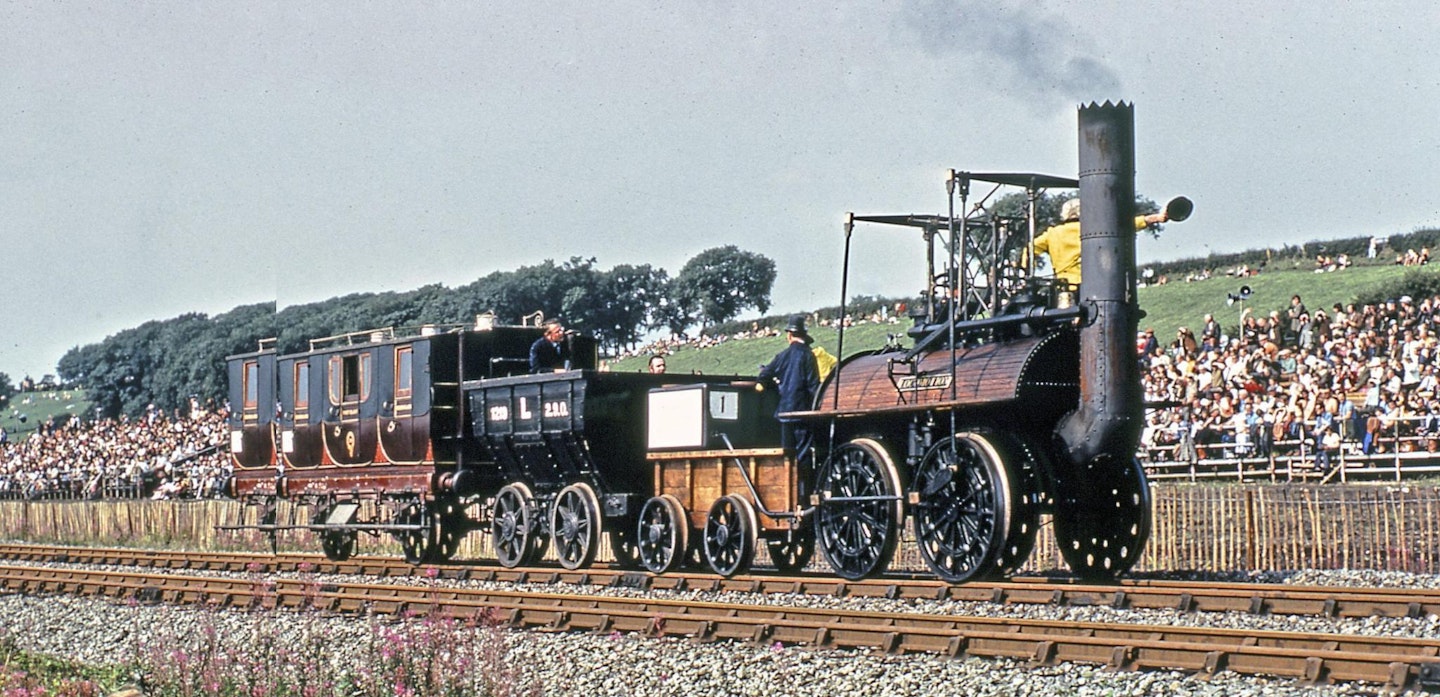
Main line, museum, and worse: What’s happened to the exhibits?
(Engines listed in order of appearance)
1975 No. 1 Locomotion replica
1975: Beamish
2025: Ruddington
Status: Operational
A replica of the engine that hauled the first train over the S&DR in September 1825 was constructed at Beamish to deputise for the fragile original, which was clearly unable to be steamed for the Cavalcade. The creation of engineer Mike Satow, it has been widely travelled, including to the United States and Japan. Following recent restoration, Locomotion has been running trials on the Great Central Railway (Nottingham) at Ruddington. Its axles and chimney have been replaced, and firebox and motion repairs carried out. Beamish
Bagnall ‘Austerity’ 060ST NCB No. 2502/7
1975: Seaham
2025: Marley Hill
Status: Awaiting overhaul
Industry was represented by a Hunslet-design ‘Austerity’ originally built for the Ministry of Supply (Works No. 2779, No. WD75256 at the Longmoor Military Railway), from Vane Tempest Colliery at Seaham, which closed in 1993. It was repainted with striped bufferbeams. The engine is now ‘Gamma’ at the close-by Tanfield Railway, and is stored at Marley Hill shed, painted black as its No. 20.
LMS ‘Black Five’ No. 4767 (44767) ‘George Stephenson’
1975: Thornaby
2025: Carnforth
Status: Under overhaul
Ian Storey’s unique ‘Black Five’ with Stephenson link motion was named ‘George Stephenson’ at Shildon on August 25 by William Whitelaw MP (grandson of an LNER Chairman, and later Conservative Deputy Prime Minister) to commemorate the 150th anniversary of the Stockton & Darlington Railway, and it still carries the plates. No. 44767 has visited many preserved lines since then and enjoyed long periods on the main line, including many stints on the Fort William-Mallaig run. Last steamed in 2014, it was sold to the West Coast Railway Company in 2018, and new cylinders and a tender tank are on the repairs list. Thornaby
NER ‘T2’ 080 No. 2238 (63395)
1975: NYMR
2025: NYMR
Status: Under repair
The unglamorous LNER ‘Q6’ heavy freight engine arrived at Shildon from Grosmont in a trio that also included ‘K1’ No. 2005 and ‘P3’ No. 2392, having recently undergone a mechanical overhaul and large flue tube replacement. The journey included a stop at Thornaby depot for attention to its tender. Withdrawn in 1982, it returned to steam again in 2008. It is currently being fitted with a new right-hand cylinder, after its original item failed in May 2023, and the 0-8-0 is expected to return to service soon. NYMR
NER ‘P3’ 0-6-0 No. 2392 (65894)
1975: NYMR
2025: NYMR
Status: Operational
The last of a class of 115 sturdy engines that saw out North Eastern steam in September 1967, the ‘J27’ spent many years allocated to York. After an initial overhaul, it was withdrawn immediately after the cavalcade for boiler repairs, and has been on hire to such diverse places as the Llangollen, Bo’ness & Kinneil, and Nene Valley railways. Its most recent overhaul was completed in 2018, outshopped in BR condition as No. 65894 with a new tender body and steam-heating equipment, and was repainted into the LNER condition as No. 2392 in 2023.
LNER ‘K1’ 2-6-0 No. 2005 (62005)
1975: NYMR
2025: Carnforth
Status: Under overhaul
The restoration of the engine that precariously finished up its BR career as a stationary boiler was completed by NELPG members at Thornaby depot a year before the cavalcade. It was painted in non authentic lined-out LNER Apple green livery, later changed to standard BR lined black. No. 62005 has been a main line stalwart over the ensuing decades and a regular sight on the West Highland line. Last steamed in 2021, it is close to the end of a half-million-pound rebuild that includes major firebox work and new tyres, and should be back in service later this year, returning to its familiar ‘Jacobite’ duties. NYMR
Caledonian Railway ‘439’ 0-4-4T No. 419 (55189)
1975: Falkirk
2025: Bo’ness
Status: Operational
The popular (and colourful) Scottish McIntosh ‘439’ class suburban passenger tank had already been restored, in 1971, before it was selected for participation at Shildon, and it partnered LNER ‘D49’ No. 246 Morayshire for the exhilarant main line run south. The 0-4-4T has been a roving ambassador for the Scottish Railway Preservation Society over the years, having paid visits to such diverse places as the Churnet, Chinnor & Princes Risborough, Bluebell and Spa Valley railways. Its most recent overhaul was completed in October 2018 and it is currently being repainted into LMS Crimson Lake as No. 15189. Falkirk
LNER ‘D49’ 4-4-0 No. 246 (62712) Morayshire
1975: Falkirk
2025: Bo’ness
Status: Under overhaul
The ‘D49s’ were once common in the North East, but Morayshire – the final ‘D49’ in BR service – ended its working life in Scotland, from where it steamed from on August 4 1975 with Caledonian No. 419 and three vintage coaches Eyebrows were raised at Morayshire’s distinctive, almost dayglow, shade of LNER green paint. The 440’s original Falkirk base was closed in favour of the Bo’ness & Kinneil Railway in 1979, and No. 246 continued running on the main line until 1983. Last steamed in 2015, its overhaul is currently ongoing at Bo’ness.
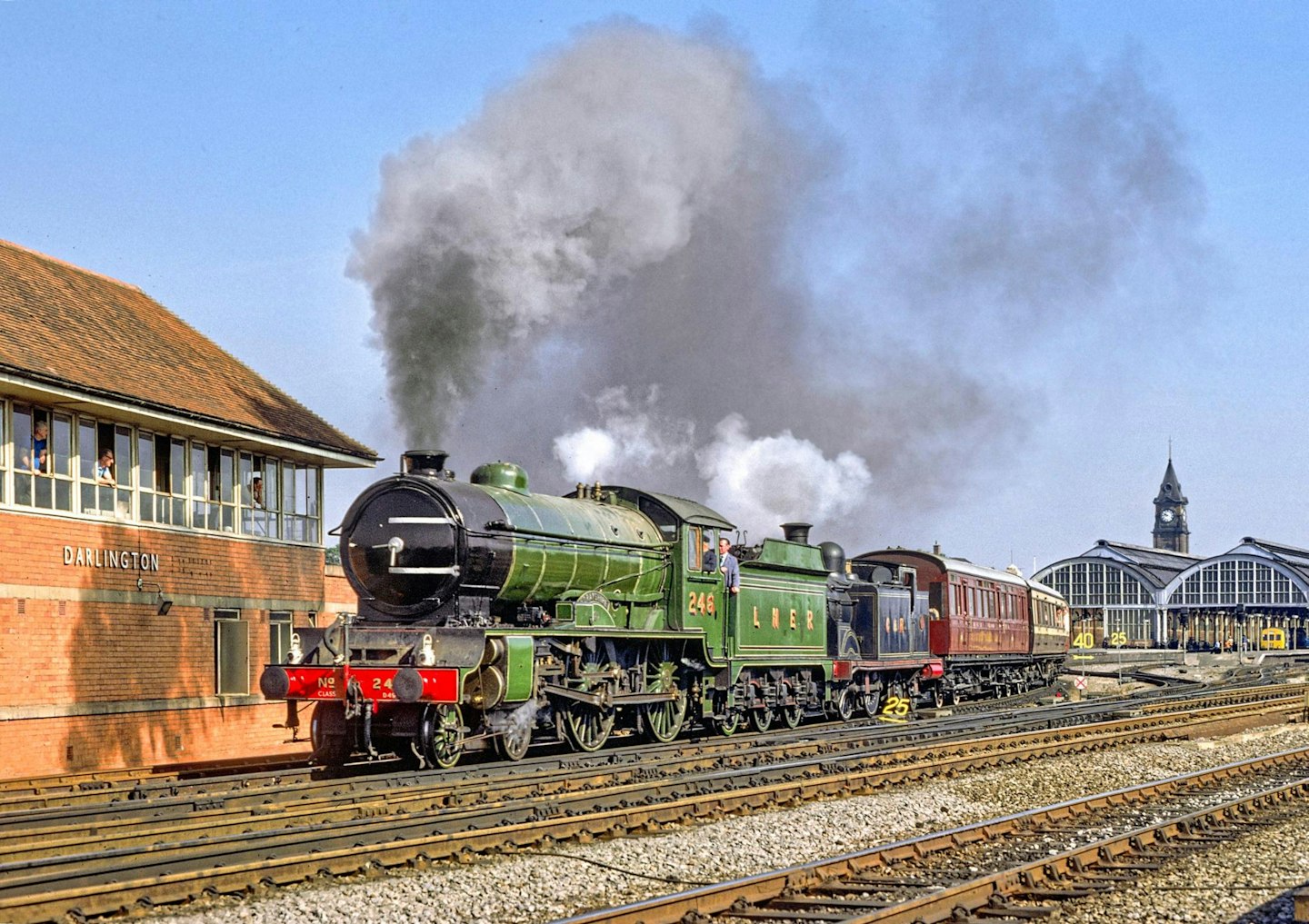
GWR ‘57XX’ 060PT No. 7752
1975: Tyseley
2025: Tyseley
Status: Awaiting overhaul
As London Transport No. L94, No. 7752 famously hauled the last steam train on the ‘Met’ in June 1971 and was repainted in full GWR unlined green for the 1975 cavalcade. It travelled under its own power from Tyseley, combining with Ivatt ‘2MT’ No. 41241 and a rake of three Keighley & Worth Valley coaches at York. Since then, No. 7752 has run often on the main line and worked on other railways, but bowed out of traffic in late 2021 for overhaul.
GWR ‘Manor’ 460 No. 7808 Cookham Manor
1975: Didcot
2025: Didcot
Status: Static display
Although the longest preserved ‘Manor’ and the only one of the nine survivors to have been purchased directly from BR, No. 7808 is not on any priority list to return to steam in the foreseeable future, having last been used in 1983. Cookham Manor was in sound mechanical shape for its 500-mile round trip from Didcot to the North East in 1975, arriving in splendid fashion at the head of a rake of five veteran coaches.
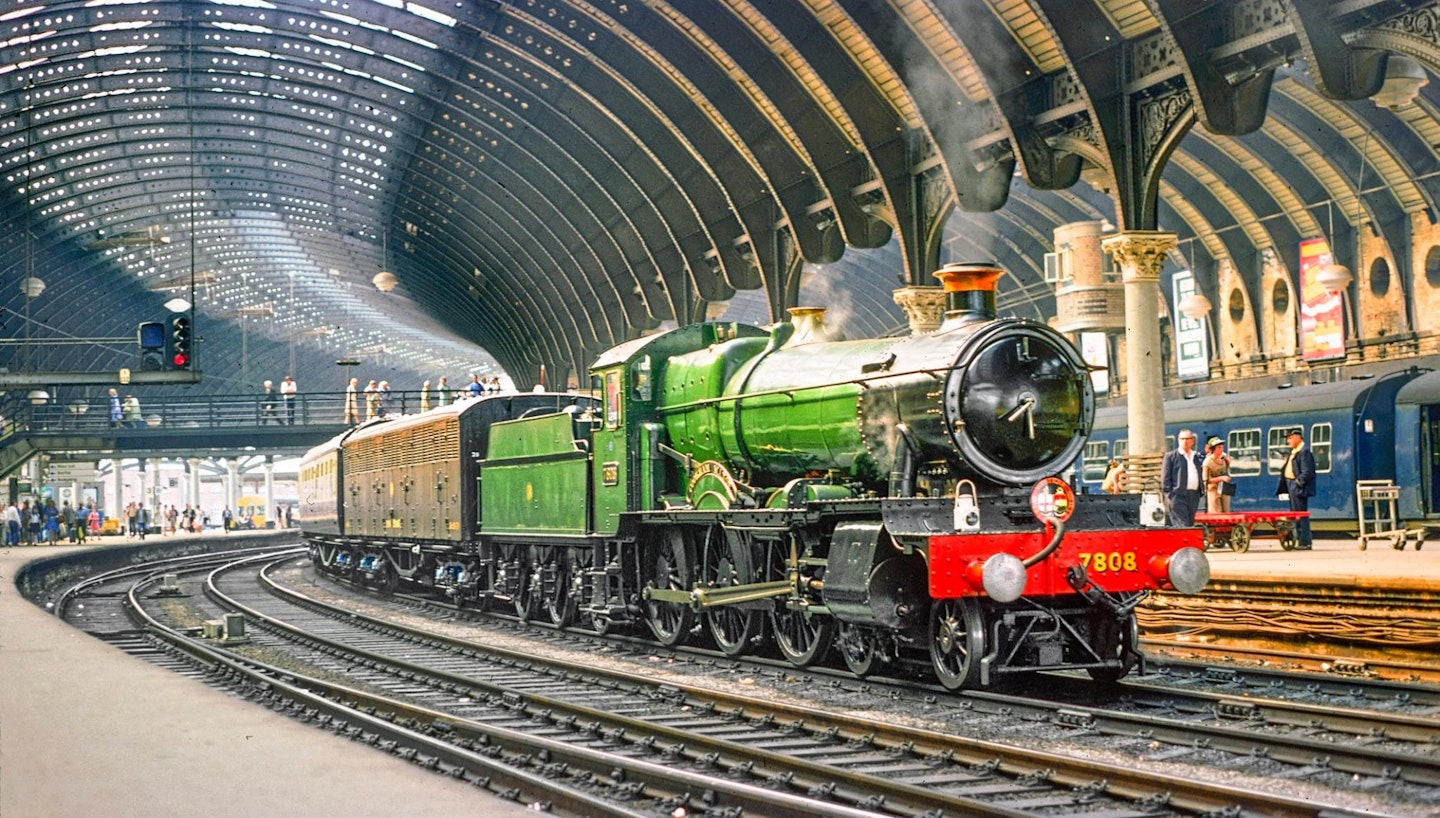
GWR ‘Modified Hall’ 460 No. 6960 Raveningham Hall
1975: Carnforth
2025: Margate
Status: Awaiting overhaul
It only took three years to restore this wartime ‘Hall’ from Barry condition to become a Shildon Cavalcade participant, and a few questions were asked about its overall suitability after it failed twice on its journey north from its then-base at Carnforth. It was a familiar sight on the Gloucestershire Warwickshire, Severn Valley, and West Somerset railways over the intervening years. No. 6960 last steamed in July 2021 and its currently in storage at owner Jeremy Hosking’s One
LNER ‘V2’ 262 No. 4771 (60800) Green Arrow
1975: Carnforth
2025: Danum Gallery, Library & Museum, Doncaster
Status: Static display
The Gresley ‘V2’ was shunted from pillar to post in the eight years following its initial restoration into LNER Apple green at Doncaster in early 1963. Once intended for display at a museum in Leicester, it was returned to working condition at Norwich shed, and later based at Carnforth for main line use from 1973. It was therefore easy for it to motor over to Shildon with four support coaches. Carnforth Time was called for Green Arrow in 2008 owing to its cracked cylinder monobloc, and in February 2021 it was relocated to the Danum Gallery, Library & Museum at Doncaster. Although the National Railway Museum has not ruled out a return to steam, as yet there are no plans to overhaul No. 4771.
LNER ‘B1’ 460 No. 1306 (61306) ‘Mayflower’
1975: Carnforth
2025: Crewe
Status: Operational
The expected treat of the arrival at Shildon of ‘Mayflower’ double-heading GWR No. 6960 Raveningham Hall on August 11 1975 failed to materialise because the ‘Hall’ was taken off at York with a hot box. The BR-built ‘B1’ had been transformed with a repaint from BR black to smart LNER lined Apple green with a red nameplate. The ‘B1’ has since had extensive main line use, and changed hands a number of times, notably to Gerald Boden, David Buck and, in 2022, to Jeremy Hosking. It is now part of his Locomotive Services Group and a regular sight at the head of Saphos Trains railtours.
LMS ‘8F’ 280 No. 8233 (48773)
1975: Severn Valley Railway
2025: Severn Valley Railway
Status: Static display
The remarkable Second World War and BR end of steam veteran already had seven years of preservation service under its belt by the time of the 1975 cavalcade, having arrived at the Severn Valley Railway direct from BR in full working order, and it hauled trains during its official reopening in May 1970. After some necessary mechanical attention, the Stanier 280 appeared at Shildon in the guise of No. 8233, its original LMS number, and worked from the SVR to Shildon with Ivatt ‘4MT’ No. 43106 and three coaches in tow. No. 48773 has since enjoyed several stints in traffic, as well as main line use from the late 1980s until 2000, but has been silent since its boiler ticket expired in January 2008. It is currently on show at The Engine House at Highley; an estimated £1 million is needed to revive it. Severn Valley Railway
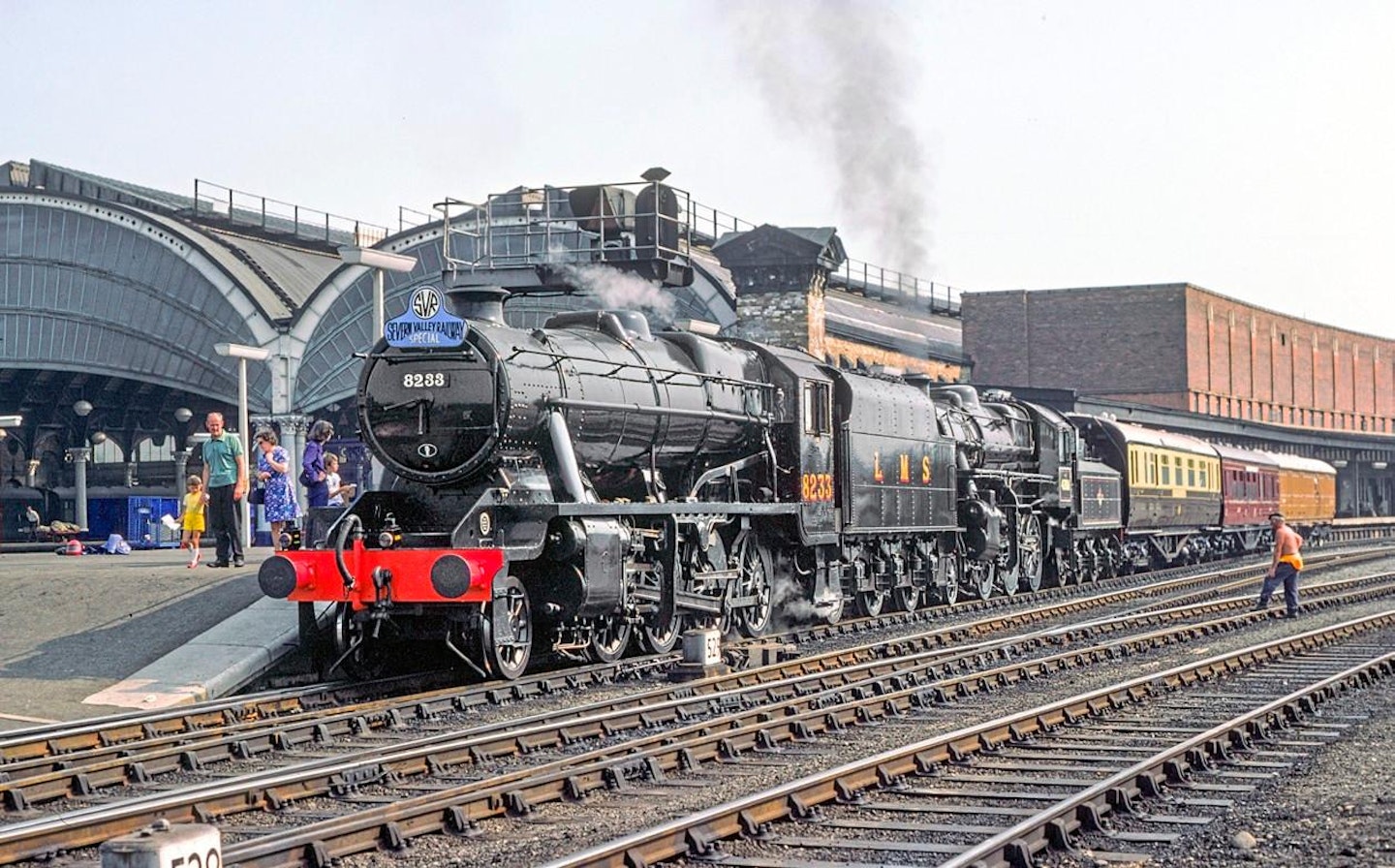
War Department ‘Austerity’ 2 10 0 No. 600 Gordon
1975: Severn Valley Railway
2025: Severn Valley Railway
Status: Static display
A somewhat colourful entry owing to its blue and red livery, applied while in service at the Longmoor Military Railway, Gordon (named after General Gordon of Khartoum) was intended for war service overseas, but never made it beyond Southampton. Initially restored at the SVR in 1972, it did, however, get to Shildon, under its own power, and again to Rainhill in 1980. The Riddles 2 10 0 has had two ‘tickets’ in preservation, from 1972 until 1984, and 1990 until 1999, and is another static exhibit at the SVR’s Highley Engine House. An eventual return to steam is currently a long-term prospect.
Metropolitan Railway Bo Bo No. 12 Sarah Siddons
1975: Ruislip
2025: Ruislip
Status: Operational
Mentioned for completeness is the Metropolitan Railway electric locomotive Sarah Siddons, which needed a tow from London to Shildon behind Class 25 diesel No. 25263, It came with a 1973 Piccadilly Line three-car unit, consisting of vehicles Nos. 165, 365 and 565, and the engine was towed in the cavalcade by ‘WD’ No. 600 Gordon. It is still a main line engine (it was repainted at Eastleigh last year) but has not run since 2019.
LNER ‘A4’ 4 6 2 No. 4498 (60007) Sir Nigel Gresley
1975: Philadelphia
2025: Crewe
Status: Operational
The ever-present 100th Gresley ‘Streak’ was in fine fettle for its participation in the 1975 cavalcade (in LNER Garter blue livery), having only recently returned to main line action following the lifting of BR’s infamous steam ban in 1971. Bowing out for overhaul the month after the cavalcade, Sir Nigel Gresley has been an almost omnipresent sight on the main line and heritage railways in the years since, and emerged from its most recent overhaul in March 2022. However, it hasn’t appeared in LNER Garter Blue since the mid-1990s, having carried lined BR blue almost exclusively ever since, aside from a brief stint in LNER wartime black,
GNR Stirling ‘Single’ 422 No. 1
1975: NRM, York
2025: NRM, York
Status: Static display
The iconic GNR single wheeler was not in steam at the cavalcade, but hauled by No. 4498 Sir Nigel Gresley. There had been a minor scare when it was derailed on the Darlington turntable soon after arrival on August 22, but no damage was done. A favourite of the late John Bellwood, the NRM’s CME, No. 1 was remarkably returned to steam at the Great Central Railway from 1981-82, and at the North Yorkshire Moors Railway from 1983-85, before bowing out for good. Now a static exhibit again, one aesthetic change from its appearance at Shildon in 1975 was being paired with an authentic Stirling tender in May 2014, having spent decades paired with a non-authentic Sturrock vehicle.
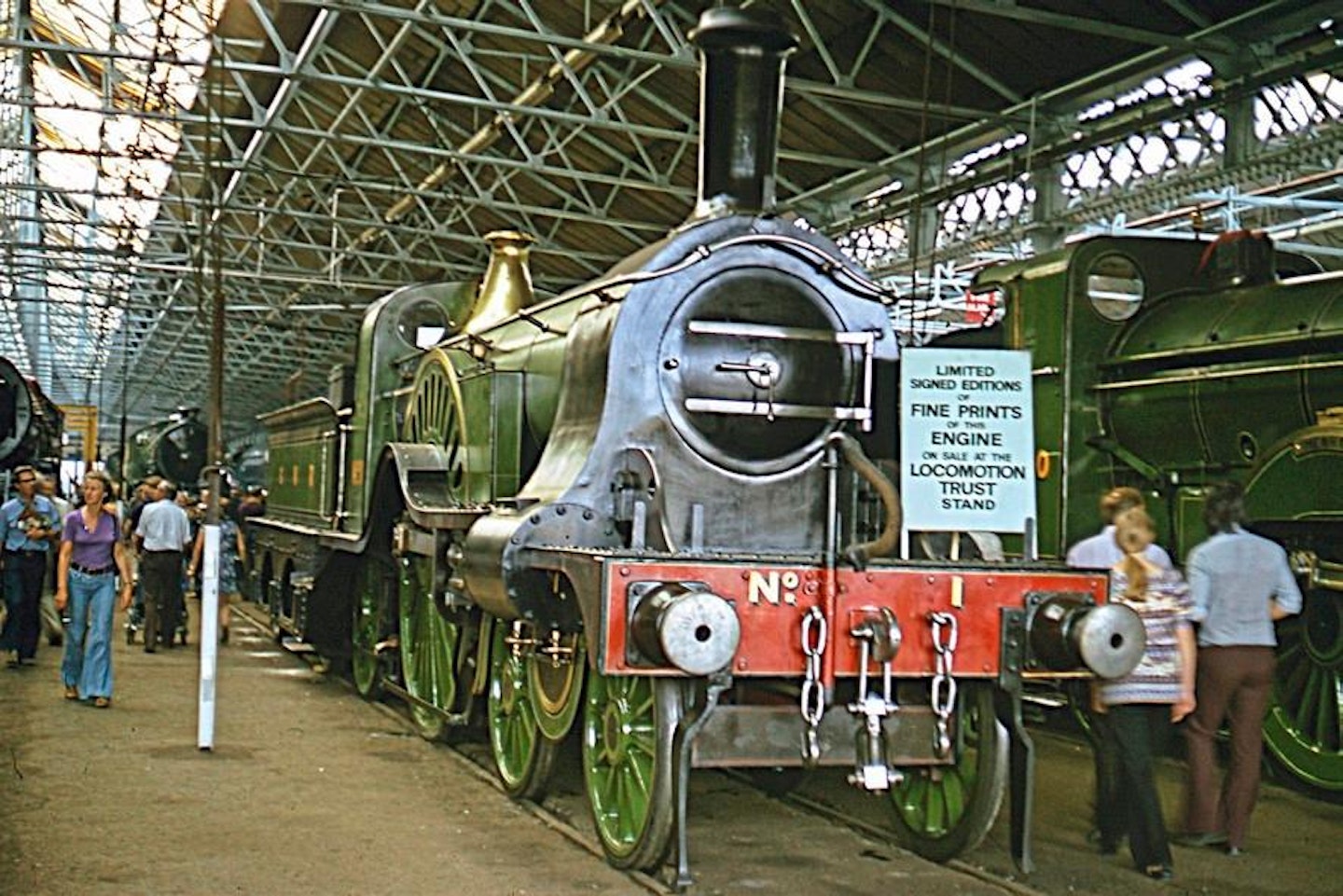
LNER ‘A3’ 462 No. 4472 (60103) Flying Scotsman
1975: Carnforth
2025: York
Status: Operational
Although it was already world-famous, Flying Scotsman had to compete for attention at Shildon with so much else to see. The engine had steamed in from Carnforth with LNWR 240 Hardwicke for company. The ‘A3’s’ career since 1975 is well documented and not worth repeating at length here, but its latest overhaul was completed in October 2022 and, after over a year spent on the side lines at both the National Railway Museum in York and Locomotion, Shildon, it has recently returned to full operational condition. However, it is as-yet unknown whether it will play an active role in the ‘Railway 200’ festivities, and it last appeared in single-chimney condition as No. 4472 in March 1993. Carnforth
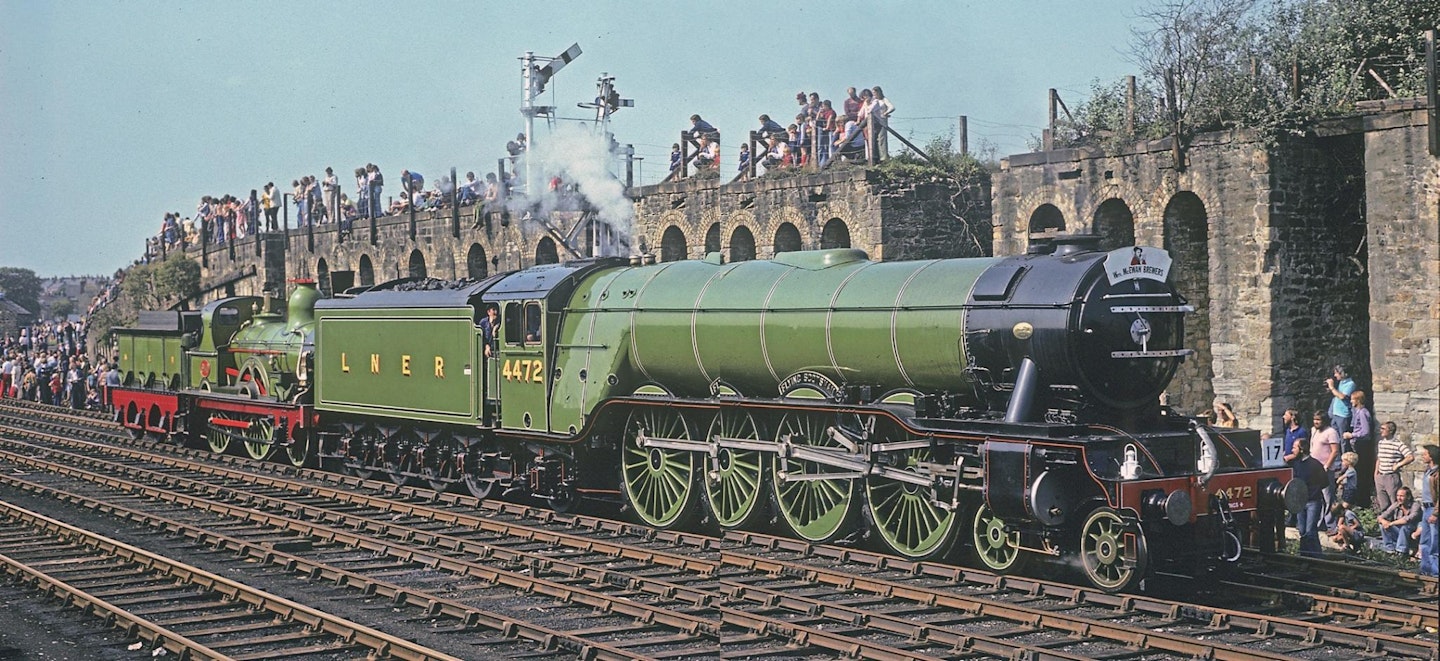
NER ‘901’ 240 No. 910
1975: York
2025: Shildon
Status: Static display
In its early years, the LNER was good at saving historic engines, and express passenger No. 910, the first of a class of 55, was laid aside for the 1925 S&D centenary procession. It had also appeared at the 1875 event. The 240 was present again half a century later for a third time, albeit not in steam but coupled behind Flying Scotsman. The engine remains in the National Collection, and after a spell on display back on ‘home territory’ at Kirkby Stephen East on the former Stainmore Route from 2011 until 2024, it is currently receiving cosmetic attention at Locomotion, Shildon.
GNR ‘C2’ 442 No. 990 Henry Oakley
1975: York
2025: York
Status: Static display
Britain’s first proper ‘Atlantic’, which always keeps the name of the Great Northern Railway general manager in our minds, had the honour of hauling Stirling ‘Single’ No. 1 along the East Coast Main Line to Shildon. No. 990, the first of Henry Ivatt’s 20 ‘Klondikes’ created the Doncaster family likeness that continued beyond his successor Gresley and right to the end of the LNER’s existence. Withdrawn from regular service in 1937, No. 990 was briefly reactivated at BR’s behest for two ‘Plant Centenarian’ railtours marking the 100th anniversary of Doncaster Works in 1953 before returning to static display. Revived for the 1975 cavalcade, it remarkably ran at the Keighley & Worth Valley Railway from 1977-78 before bowing out for good. It is currently on display at the NRM in York.
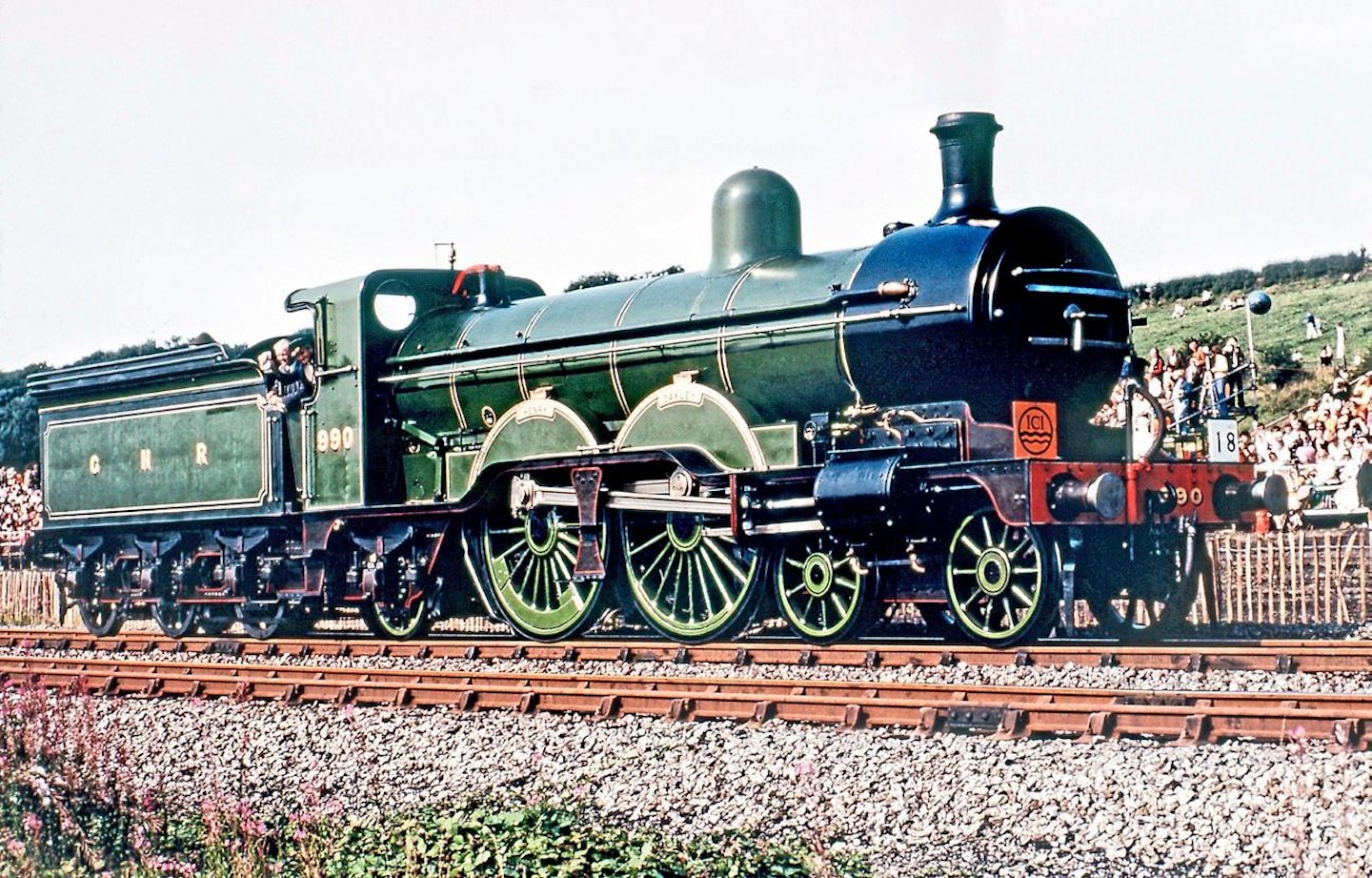
In Part 2, we will continue exploring the 1975 locomotives, with details of the static exhibits, and the fate of some of the coaching stock.
Each issue of Steam Railway delivers a wealth of information that spans the past, present and future of our beloved railways. Featuring stunning photography, exclusive stories and expert analysis, Steam Railway is a collector's item for every railway enthusiast.
Choose the right subscription for you and get instant digital access to the latest issue.

